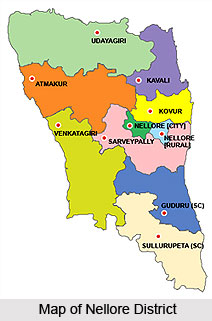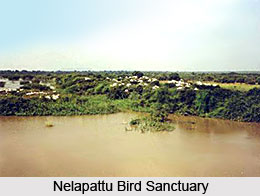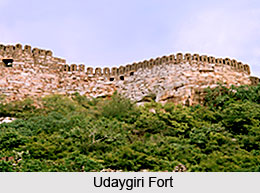 Nellore or Amarajeevi Potti Sri Ramulu Nellore District is one of the 23 districts of Andhra Pradesh. The administrative head of the district is the Nellore city. The district is located towards the south-eastern part of Andhra Pradesh. The district is famous for its paddy fields and hence had got its name from the word `nelli` the meaning of which is paddy. The district was called Nellore till June 2008 but soon after that the district got the name of Amarajeevi Potti Sri Ramulu Nellore District after one of the famous freedom fighters of the district. For the sake of proper administration the district has been divided into 46 mandals under 3 Revenue Divisions.
Nellore or Amarajeevi Potti Sri Ramulu Nellore District is one of the 23 districts of Andhra Pradesh. The administrative head of the district is the Nellore city. The district is located towards the south-eastern part of Andhra Pradesh. The district is famous for its paddy fields and hence had got its name from the word `nelli` the meaning of which is paddy. The district was called Nellore till June 2008 but soon after that the district got the name of Amarajeevi Potti Sri Ramulu Nellore District after one of the famous freedom fighters of the district. For the sake of proper administration the district has been divided into 46 mandals under 3 Revenue Divisions.
History of Nellore District
Nellore was known by the name of Vikrama Simhapuri till 13th century.
As far as history of the district is concerned, the district had an important role during the emergence of Telugu language and the formation of the state of Andhra Pradesh. It had been under the rule of Maurya Dynasty, Satavahana Kings, Kakatiyas, Pallavas, Cholas, Telugucholas, Pandyas and other dynasties.
Before the district was taken over the British it was ruled by the Nawabs. During the British rule the district was at peace and did not undergo any major political changes.
The period after Indian independence brought about major political changes in the district. For instance till 1st October 1953, the district was part of the Madras (now Chennai) state but on 1st November, 1956 when the states were recognised on the basis of linguistic differences, the state of Andhra Pradesh came into existence. During that time Nellore had played an important role in the formation of the state and Potti Sriramulu, a Telugu patriot and activist had given a lot of effort to set up Andhra Pradesh.
Geography of Nellore District
The global position of the district is between 13.30` and 15.6` of Northern latitude and 70.5` and 80.15` of Eastern longitude. It has a total land area of 13,076 square kilometers. The boundaries of the district are as follows Bay of Bengal to the east, Tamil Nadu to the south, Cuddapah district and Prakasam to the north and in the east the district is bordered by the low lying bases of the Eastern Ghats.  The main rivers of the region are River Pennar, Swarnamukhi and Gundlakamma. The average elevation of the district is 19 meters and has a coastline which measures 163 kilometers.
The main rivers of the region are River Pennar, Swarnamukhi and Gundlakamma. The average elevation of the district is 19 meters and has a coastline which measures 163 kilometers.
Nellore can be divided into two parts physically. The eastern part of the region is the coastal region which is more or less fertile in nature whereas the western part is rocky in nature. The climate of Nellore district can be characterized as dry and salubrious. The hottest months of the region are April and May. The maximum and minimum temperatures of the district are 36-46c during summer and 23-25c during winter. Most of the rainfall in the region is brought about by the north-east monsoon winds and the average annual rainfall of the region is between 700 and 1000mm.
The district is also well known for its rich flora and fauna. Besides the presence of a lush green flora, the district also has an impressive fauna which adds to the beauty of the district.
Demography of Nellore District
Recorded by the census of 2001, the district has a population of 2,668,564. Most of the people in the area are rural based. The density of population in the district is 203 persons per square kilometer. The number of literates in the district is 1546252 which equals to almost 58 percent of the total population.
Culture of Nellore District
As most of the people in Nellore dwell in villages, their way of life is more traditional in nature. Although the males of the district are seen in pants and shirts, more number of male prefers dhotis and lungis. The women, on the other hand, limit themselves to sarees.
Telugu is the most common language that is spoken in Nellore district. Besides Telugu the other languages that are spoken in the region are Tamil. Hence it can be said that the people of Nellore district are more traditional in nature and love to adhere to their roots.
As far as art and literature is concerned, Nellore has produced many great poets and literary personalities of fame.
The major form of entertainment in the district is movies. People in the region love watching movies of various kinds.
Education of Nellore District
Nellore district has a number of schools, degree colleges and also engineering colleges. Even many medical colleges which include dental colleges are also present in the region. In fact the district has a heritage of being an important educational center right from the early dates which dates back to the period of formation of Andhra Pradesh.
Economy of Nellore District
The factors which have aided the economy of Nellore to flourish are proximity to the sea and fertile land towards the eastern part of the district. The district has a cultivable area equal to 41.3 percent. The predominant occupation of the people of Nellore is agriculture and the crops which are most commonly grown in the district are Paddy, Jowar, Bajra along with Tobacco, Chillies, Groundnut and sugarcane. Based on these crops a number of agro based industries have come up in the district like rice bran oil plants, rice and paraboiled rice mills and sugar factories.
Aqua culture in the district is also of prime importance. It includes prawn and fish culture. Many people in the district depend on aqua culture for their subsistence.
The handloom sector of the district is also a major small scale industry of the district and a large number of people depend on it for living. Some of the important industries of the region are Mica Mines and thermal power plant. The Krishnapatnam port which is located 20 kilometers from the district serves as a major center for economic activity of the district.
Tourism of Nellore District
Nellore has some awesome tourist spots which have immensely contributed to the tourism potential of the district. The region has a combination of religion, nature and history in its expanse of tourism. Some of the famous temples of the region are Ranganayaka Temple, Jonnawada, Penchalakona and a lot more. The places in Nellore district which are a treat for the eyes of a traveller are Somasila Dam, Kandaleru Dam, Pulicat Lake and the Nelapattu Bird Sanctuary. The Udaygiri fort which is at a distance of 100 kilometers from Nellore stands as a historical testimony of the region.






